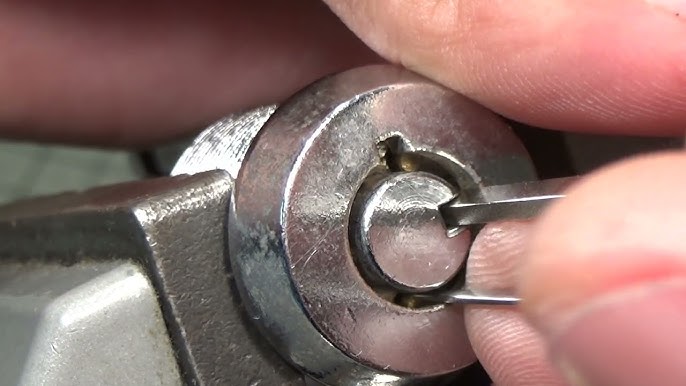Tubular locks are widely used in various applications, from securing sensitive documents to keeping valuables safe. Understanding how these locks work is the first step in learning how to pick them.
Unlike traditional pin tumbler locks, which rely on a series of pins to align and allow the lock to turn, tubular locks use a different mechanism.
Tubular locks consist of a cylindrical keyway with pins arranged in a circular pattern. Each pin is spring-loaded and has a unique height.
When the correct key is inserted into the lock, the pins align with the shear line, allowing the lock to turn. However, when attempting to pick a tubular lock, we need to mimic the key’s function by manipulating the pins to align with the shear line.
Tools Needed for Picking a Tubular Lock
Before delving into the process of picking a tubular lock, it’s essential to gather the necessary tools. While there are specialized lock-picking tools available, you can also use everyday items found around the house.
- Tubular Lock Pick: This tool is specifically designed for picking tubular locks. It features a cylindrical body with several pins that correspond to the pins in the lock. The tubular lock pick allows you to manipulate the pins individually, emulating the action of a key.
- Tension Wrench: A tension wrench is a crucial tool for any lock-picking endeavor. It applies rotational pressure to the lock, mimicking the key turning motion when inserted correctly. This tension is necessary to keep the pins in place once they have been manipulated.
- Optional: Ballpoint Pen: While not a conventional lock-picking tool, a ballpoint pen can be used as an alternative method for picking tubular locks, as we will discuss later in this tutorial.
Step-by-Step Guide on How to Pick a Tubular Lock
Now that we understand the basics of tubular locks and have the necessary tools at our disposal, let’s dive into the step-by-step process of picking a tubular lock.
- Prepare the Lock Pick: If you are using a specialized tubular lock pick, ensure that the pins are properly aligned with the lock’s pin chambers. The pins should be flush with the lock pick’s body.
- Insert the Tension Wrench: Take the tension wrench and insert it into the bottom of the lock’s keyway. Apply slight rotational pressure in the direction you would turn the key.
- Insert the Lock Pick: Insert the lock pick into the keyway, making sure all the pins are inside the lock. Gently push the lock pick in until you feel resistance.
- Manipulate the Pins: Slowly rotate the lock pick while applying slight upward pressure on each pin. As you rotate the lock pick, pay attention to the feedback from the pins. Some pins may bind or feel stiffer than others. These are the pins that need to be manipulated to align with the shear line.
- Set the Pins: As you manipulate each pin, listen for a faint click or feel a subtle movement. These indications suggest that the pin has reached the correct position. Repeat this process for all the pins in the lock.
- Turn the Lock: Once all the pins are set, apply continuous rotational pressure to the tension wrench. If you’ve successfully aligned all the pins with the shear line, the lock should turn, allowing you to open it.
How to Use a Tubular Lock Pick
Using a tubular lock pick can be an effective method for picking tubular locks. The specialized tool allows for precise manipulation of the pins, mimicking the action of a key. Here’s a step-by-step guide on how to use a tubular lock pick:
- Prepare the Tubular Lock Pick: Before using the tubular lock pick, make sure the pins are aligned with the lock’s pin chambers. The pins should be flush with the lock pick’s body.
- Insert the Tension Wrench: Insert the tension wrench into the bottom of the lock’s keyway. Apply slight rotational pressure in the direction you would turn the key.
- Insert the Tubular Lock Pick: Insert the tubular lock pick into the keyway, ensuring that all the pins are inside the lock. Gently push the lock pick in until you feel resistance.
- Manipulate the Pins: Slowly rotate the lock pick while applying slight upward pressure on each pin. As you rotate the lock pick, pay attention to the feedback from the pins. Some pins may bind or feel stiffer than others. These are the pins that need to be manipulated to align with the shear line.
- Set the Pins: As you manipulate each pin, listen for a faint click or feel a subtle movement. These indications suggest that the pin has reached the correct position. Repeat this process for all the pins in the lock.
- Turn the Lock: Once all the pins are set, apply continuous rotational pressure to the tension wrench. If you’ve successfully aligned all the pins with the shear line, the lock should turn, allowing you to open it.
Picking a Tubular Lock with a Ballpoint Pen
In some situations, you may not have access to specialized lock-picking tools, but fear not! It is possible to pick a tubular lock using a ballpoint pen as an alternative method.
Here’s a step-by-step guide on how to pick a tubular lock with a ballpoint pen:
- Prepare the Ballpoint Pen: Remove the ink cartridge from the pen, leaving only the hollow tube. Ensure that the tube is clean and free from any obstructions.
- Insert the Tension Wrench: Insert the tension wrench into the bottom of the lock’s keyway. Apply slight rotational pressure in the direction you would turn the key.
- Insert the Ballpoint Pen: Insert the hollow tube of the ballpoint pen into the keyway, making sure all the pins are inside the lock. Gently push the pen tube in until you feel resistance.
- Manipulate the Pins: Slowly rotate the pen tube while applying slight upward pressure on each pin. As you rotate the pen tube, pay attention to the feedback from the pins. Some pins may bind or feel stiffer than others. These are the pins that need to be manipulated to align with the shear line.
- Set the Pins: As you manipulate each pin, listen for a faint click or feel a subtle movement. These indications suggest that the pin has reached the correct position. Repeat this process for all the pins in the lock.
- Turn the Lock: Once all the pins are set, apply continuous rotational pressure to the tension wrench. If you’ve successfully aligned all the pins with the shear line, the lock should turn, allowing you to open it.

